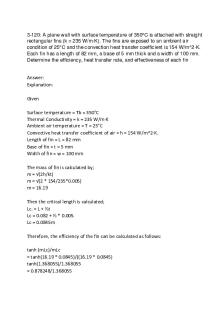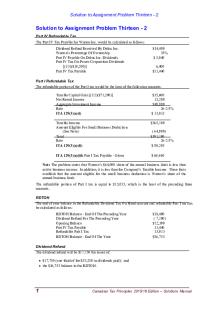Solution 3 PDF

| Title | Solution 3 |
|---|---|
| Course | Introduction to Artificial Intelligence |
| Institution | University of Oregon |
| Pages | 5 |
| File Size | 125.2 KB |
| File Type | |
| Total Downloads | 63 |
| Total Views | 130 |
Summary
Solutions to homework assignment 3...
Description
Assignment 3 (CIS 471/571) November 4, 2015
Solutions
Question 1 Please specify each of following sentences is correct or not, why? a. (A ∧ B) |= (A ⇔ B ) This is correct because (A ∧ B) is true in model where A = T rue and B = T rue, in which case (A ⇔ B) is also True. b. (A ∧ B) ∨ ¬(B ⇒ A) is satisfiable This is correct because (A ∧ B) is satisfiable for A = T rue and B = T rue which means there is at least one model for which the sentence is true and hence satisfiable. This model is also satisfiable for A = F alse and B = T rue for ¬(B ⇒ A) c. (¬Smoke ⇒ ¬F ire) ⇒ (F ire ⇒ Smoke) is valid Simplifying the sentence (Smoke ∨ ¬F ire) ⇒ (¬F ire ∨ Smoke) ¬(Smoke ∨ ¬F ire) ∨ (¬F ire ∨ Smoke) (¬Smoke ∧ F ire) ∨ (¬F ire ∨ Smoke) The two disjunctions are complement of one another and satisfy all the truth values assignment which makes the above sentence valid. The above statement is correct. d. ∃x Smart(x) ∨(x ∨ ¬x) is valid This is incorrect because x is a variable here and we can’t say for variables whether x ∨ ¬x holds true or false. And for cases of T rue and F alse, we cannot infer anything about Smart(T rue) because it doesn’t make any sense. e. ∃x playFootballFor(x, UO) ⇒ P AC12Champion(x) This can be rewritten as ∃x¬playF ootballF or(x, U O) ∨ P AC12Champion(x) It is true for anyone who doesn’t play football for UO and it doesn’t matter whether s/he gets national PAC12 Championship or not. It is a weak statement. This statement is incorrect
1
f. ∀x¬(¬playF ootballF or(x, U O) ∨ ¬P AC12Champion(x)) This can be reduced to ∀x(playF ootballF or(x, U O) ∧ P AC12Champion(x)) This is incorrect because it is too strong. Not everyone plays football for UO and not everyone gets PAC12 Champion. g. (∃x Likes(x,Broccoli) ∧¬hasCancer(x)) ⇔ (¬∀x¬Likes(x, Broccoli) ∨hasCancer(x)) Using De Morgan’s law on right of biconditional (∃x Likes(x,Broccoli) ∧¬hasCancer(x)) which is the same as left hand side, thus making the statement correct.
Question 2 Assume you have a manufacturing process for the creation of Google cars. There are 2000 different parts that are combined together to make a Google car. There are many different versions of these parts, however, and not all versions of parts are compatible with each other. A knowledge base is created that lists all the rules for the allowable combinations of versions of parts, and it is written entirely in Horn form. Which technique would be the best (resolution, backward chaining, or forward chaining) for asking the knowledge base if a particular combination of 20 parts is allowed? Justify your answer. Answer Backward chaining is better. Backward chaining starts with a list of goals (or a hypothesis) and works backwards from the consequent to the antecedent to see if there is data available that will support any of these consequent. While, Forward chaining starts with the data and reasons its way to the answer. Resolution (while being complete) also generates large number of rules due to the order of resolution not being fixed and not being absolutely goal driven. In this particular problem, the completely grounded KB (facts) is undefined and could be very large for all possible combinations from versions of parts. Backward chaining is better in time and space since we only care about these 20 parts. Question 3 Suppose there is a policy at the University of Ducks that any student who plans to finish a degree in Science major must get good score from at least one Math course. A student football player, Adams, who is in Science Major and takes the Calculus course. The instructor of the Calculus course always give good scores to all students who take the course. Calculus is a Math course. First, use first order logic sentences (including any common sense sentences) to represent all knowledge mentioned above. Based on the knowledge, will Adams finish a degree in Science Major? If yes, use both backward chaining and resolution to prove your answer. If not, also use both backward chaining and resolution to prove it. If you cannot make a conclusion, please explain why. 2
Solution Note: One most common but not completely accurate solution is given below followed by the correct solution. The statements from the above paragraph: • Adams is a University of Ducks student: DucksStudent(Adams) • Adams is a football player: F ootballP layer(Adams) • Adams is a Science Major: ScienceMajor(Adams) • Adams takes Calculus course: T akesCourse(Adams, Calculus) • Calculus is a Math course: MathCourse(Calculus) The rules from above paragraph • Rule 1 All students who take Calculus class gets good score: ∀x TakesCourse(x,Calculus) ⇒ GoodScore(x, Calculus) • Rule 2 A University of Ducks student should get good grade in a Math Course to finish a Science Degree: DucksStudent(x) ∧ ScienceMajor(x) ∧ T akesCourse(x, y) ∧ MathCourse(y) ∧ GoodScore(x, y) ⇒ F inishDegree(x) Yes, Adams will finish his degree. We use backward chaining first to reach that conclusion.
Next, we use resolution to prove our conclusion. For resolution, we convert all rules into disjunctions which are linked via conjunction. We get all the facts and rules in CNFs as 1. DuckStudent(Adams) 3
2. ScienceMajor(Adams) 3. T akesCourse(Adams, Calculus) 4. MathCourse(Calculus) 5. ¬T akesCourse(x, Calculus) ∨ GoodScore(x, Calculus) 6. ¬DucksStudent(x) ∨ ¬ScienceMajor(x) ∨ ¬T akesCourse(x, y) ∨ ¬MathCourse(y) ∨ ¬GoodScore(x, y) ∨ F inishDegree(x) For resolution, we begin with contradiction ¬F inishDegree(Adams) • Step 1, Resolving conclusion with rule (6) using {x|Adams} we get, ¬DucksStudent(Adams) ∨ ¬ScienceMajor (Adams) ∨ ¬T akesCourse(Adams, y) ∨ ¬MathCourse(y) ∨ ¬GoodScore(Adams, y) • Step 2, Resolving above with rule (1) and (2) we get, ¬T akesCourse(Adams, y) ∨ ¬MathCourse(y) ∨ ¬GoodScore(Adams, y) • Step 3, Resolving above with rule (4) using {y|Calculus} we get, ¬T akesCourse(Adams, Calculus) ∨ ¬GoodScore(Adams, Calculus) • Step 4, Resolving above with rule (3), we get, ¬GoodScore(Adams, Calculus) • Step 5, Resolving above with rule (5), we get, ¬T akesCourse(Adams, Calculus) • Step 6, Resolving above with rule (3) gives us an empty resolution. So the assumption is false. FinishDegree(Adams) is true.
Here, we are able to successfully show that Adams will finish his degree. But our interpretation of rule 2 is not completely accurate for the above solution. The completely accurate solution is given below: The statements from the above paragraph: • Adams is a University of Ducks student: DucksStudent(Adams) • Adams is a football player: F ootballP layer(Adams) • Adams is a Science Major: ScienceMajor(Adams) • Adams takes Calculus course: T akesCourse(Adams, Calculus) • Calculus is a Math course: MathCourse(Calculus)
4
The rules from above paragraph • Rule 1 All students who take Calculus class gets good score: ∀x TakesCourse(x,Calculus) ⇒ GoodScore(x, Calculus) • Rule 2 Any student who plans to finish a degree in Science major must get good score from at least one Math course. ∀x [DucksStudent(x) ∧ScienceMajor(x) ∧ F inishDegree(x) ⇒ ∃y {TakesCourse(x,y) ∧MathCourse(y) ∧ GoodScore(x, y)}] Note: The rule given above is the correct interpretation of the sentence given in the question. Now, if we use backward chaining to show Adams will finish degree, we see that there doesn’t exist any rule with consequent as FinishDegree and hence we are unable to make any progress in backward chaining. So, we cannot make any claim about whether Adams will finish his degree or not. We try to reach a conclusion by resolution, for which we first convert the rules into conjunction of disjunctions, as in previous scenario. 1. DuckStudent(Adams) 2. ScienceMajor(Adams) 3. T akesCourse(Adams, Calculus) 4. MathCourse(Calculus) 5. ¬T akesCourse(x, Calculus) ∨ GoodScore(x, Calculus) 6. ¬DucksStudent(x) ∨ ¬ScienceMajor(x) ∨ ¬F inishDegree(x) ∨ GoodScore(x, y ) 7. ¬DucksStudent(x) ∨ ¬ScienceMajor(x) ∨ ¬F inishDegree(x) ∨ T akesCourse(x, y ) 8. ¬DucksStudent(x) ∨ ¬ScienceMajor(x) ∨ ¬F inishDegree(x) ∨ MathCourse(y ) For resolution, we begin with negation of the statement we want to prove i.e. ¬F inishDegree(Adam The resolution process could be presented as: 1. We Resolve rule (1)(2) with rule(6)(7)(8) and substitute x as Adams to get ¬F inishDegree(Adams)∨T akesCourse(Adams, y), ¬F inishDegree(x)∨GoodScore(x, y) and ¬F inishDegree(x) ∨ MathCourse(y ) We could continue to resolve rules further and replace y with Calculus but since we essentially don’t get a rule (and don’t have one either) which can lead to an empty resolution with regard to negated conclusion. So, we can’t reach any conclusion about whether Adams will finish his degree or not. 5...
Similar Free PDFs

Solution 3
- 5 Pages

Tutorial 3 Solution - investment
- 3 Pages

Cengel chap 3 solution
- 145 Pages

Problem Set 3 Solution
- 6 Pages

Exercise 3-Solution
- 2 Pages

Problem set 3 solution
- 12 Pages

Solution - Topic 3
- 11 Pages

Chapter 3 - solution sheet
- 62 Pages

Chapter 3 Solution - CF2
- 6 Pages

3-120 solution
- 2 Pages

Homework 3 Solution
- 4 Pages

Solution 13 assaigment 3
- 15 Pages

Chapter 3 solution
- 20 Pages

Lab 3 solution
- 11 Pages

Problem Set 3 Solution
- 7 Pages

Solution ch 3
- 20 Pages
Popular Institutions
- Tinajero National High School - Annex
- Politeknik Caltex Riau
- Yokohama City University
- SGT University
- University of Al-Qadisiyah
- Divine Word College of Vigan
- Techniek College Rotterdam
- Universidade de Santiago
- Universiti Teknologi MARA Cawangan Johor Kampus Pasir Gudang
- Poltekkes Kemenkes Yogyakarta
- Baguio City National High School
- Colegio san marcos
- preparatoria uno
- Centro de Bachillerato Tecnológico Industrial y de Servicios No. 107
- Dalian Maritime University
- Quang Trung Secondary School
- Colegio Tecnológico en Informática
- Corporación Regional de Educación Superior
- Grupo CEDVA
- Dar Al Uloom University
- Centro de Estudios Preuniversitarios de la Universidad Nacional de Ingeniería
- 上智大学
- Aakash International School, Nuna Majara
- San Felipe Neri Catholic School
- Kang Chiao International School - New Taipei City
- Misamis Occidental National High School
- Institución Educativa Escuela Normal Juan Ladrilleros
- Kolehiyo ng Pantukan
- Batanes State College
- Instituto Continental
- Sekolah Menengah Kejuruan Kesehatan Kaltara (Tarakan)
- Colegio de La Inmaculada Concepcion - Cebu